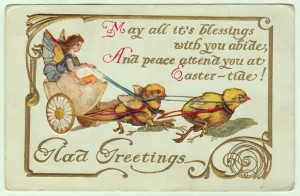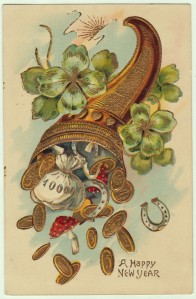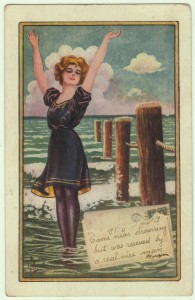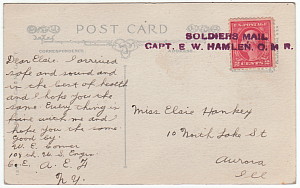September 1, 2013 by soda_santa
I have spent the Labor Day weekend so far cleaning house instead of catching up on season 2 of Revenge, or reading a favorite romance novel over again (for the fourth time) out on my patio. Yes, cleaning house; a thankless job with an endless loop. It is therefore appropriate that I came across the first of two postcard messages.

Vintage Easter postcard – Fairy Drives Cracked Egg Chariot Pulled By Chicks
“Will write you a letter later. I am in a hurry. am going to wash & scrub to-day. I guess we’re not going to have any summer.”
I wonder why the sender was in a hurry? It could be as simple as wanting to get the “wash & scrub” over with as soon as possible. I can certainly sympathize with the lack of summer comment. Today was a beautiful day – sunny, no rain, low 70s, and non-humid for once. I’ll give you 3 guesses why I spent not a minute outside enjoying it, and the first two don’t count.
On to my second antique postcard message to Miss Fannie Brand of Iowa…

1910 Antique New Year Postcard – Overflowing Lucky Coins, Mushrooms, Horseshoes.
“I hope you are not living on starvation rations any longer and that you can talk loudly and long whether you do or not. Hoping this will prove the best of New Years.”
The phrase “starvation rations” caught my eye. I plugged the phrase into bing. I learned “rationing”, and “making do” weren’t new concepts to the 1940s. Rationing also occurred in the first decade of the 20th century. With the lead-up to World War 1, food was being diverted to feed soldiers. Immigration to the US was on the rise. Let us hope Fannie was no longer on starvation rations when she received the above antique postcard.
Both postcard messages did without something – freedom to enjoy summer or leisure time in the first message, and food in the second message. How sad.
Posted in Amusing Postcard Messages | Tagged 1940s, antique, antique postcard, beautiful day, cleaning, cleaning house, doing without, endless loop, immigation, in a hurry, Iowa, Labor Day, message, novel, postcard, postcard message, rations, Revenge, romance, romance novel, sad, scrub, season 2, soldiers, starvation, starvation rations, summer, thankless job, wash, weekend, WW1 |
August 25, 2013 by soda_santa
I’ve always wondered what filled all those multi-storied buildings in big cities around the turn of the century. The Terminal Building for the Pacific Electric Railway, shown in the below vintage postcard, was such a building. One of its occupants I found to be as interesting as the building itself – The Jonathan Club.

Vintage Postcard of Pacific Electric Railway’s Terminal Building in Los Angeles. Published by Cardinell-Vincent Co.; printed in Germany.
Pacific Electric Railway Terminal Building
The Pacific Electric Building, also known as the Huntington Building, opened in 1905. This ten-floor height building was the largest building in floor area west of Chicago for several decades. It was also the terminal for the Pacific Electric Red Car Lines south and east of downtown Los Angeles.
With the increase in auto traffic in the 1920s, shared streets became congested. In 1922, the California Railroad Commission issued Order No. 9928, which required the Pacific Electric Railway to construct a subway that bypassed these congested streets.
In 2005, the building was converted into live/work lofts. The lobby currently houses artifacts from it’s days as an active railway terminal. It’s nice to know this piece of history won’t be forgotten.
The Terminal Building’s Top Occupant
The top three floors of the Pacific Electric Railway Terminal Building were occupied by one of Los Angeles’ leading businessman’s clubs – The Jonathan Club until 1925. Historical evidence supported this private club’s roots as being named after Brother Jonathan, the caricature predecessor to Uncle Sam.
Brother Jonathan was a good natured parody of all New England who came into use during the American War for Independence. He wore striped pants, somber overcoat, and a stove-pipe hat. Interesting that a club based out west, names itself after a caricature with ties to the east. After 1865, Brother Jonathan’s clothing was emulated by Uncle Sam.
(Many more antique and vintage postcards can be enjoyed by visiting my store, Remember When Vintage Postcards.)
Posted in Vintage Postcard Tidbits | Tagged artifacts, Brother Jonathan, caricature, club, downtown Los Angeles, history, Huntington, Huntington Building, Jonathan Club, Los Angeles, Pacific Electric, Pacific Electric Building, parody, postcard, private club, Red Car Lines, terminal, terminal building, turn of the century, Uncle Sam, vintage, vintage postcard |
August 18, 2013 by soda_santa
“Hello Harry. We have given up football I I guess. I had some time Thursday night. Was over south of slater. She ask all about you. Will explain all when you come home. We had a baseball workout last night I think. We will fall or they fall from 11-2.”
The Fair Weather Fan
I read the above antique postcard message recently, which mentioned giving up football. I know a little of how the writer must have felt. Professional football has just started, and already I can’t wait for the humiliation to be over with. My team, the Vikings, are 0-2 so far this pre-season. OK, I’ll admit it. I’m a fair weather Vikings fan. Maybe I’ll change; maybe not. I don’t think the writer would’ve been a fair weather fan though with an attitude of “we fall or they fall”.
Football, then Romance
The above message also mentioned a certain female someone asking after Mr. Harry Harrison of Toledo, Iowa – the recipient of the antique postcard. Her name wasn’t mentioned, so we can only assume Harry knew whom the writer was referring to. Let’s hope his bubble (romantic?) wasn’t busted when the writer explained all regarding that female someone. I tend to think not as she cared enough to ask after Harry.

1912 Antique Bathing Beauty Postcard artist signed by C. Ryan
(Many more antique postcards, including artist signed, can be found in my store – Remember When Vintage Postcards.)
Posted in Amusing Postcard Messages, Victorian Ladies | Tagged antique, antique postcard, artist signed, baseball, bathing beauty, C. Ryan, fair weather fan, female, football, IA, Iowa, postcard, postcard message, professional football, romance, Slater, Toledo, Vikings, we fall or they fall, workout | 3 Comments »
August 11, 2013 by soda_santa

Antique thanksgiving postcard. Postmarked 1911, Kelly Station PA.
I was about to post a thanksgiving antique postcard on my website, http://www.rememberwhenpostcards.com, when I thought, “why not read the message?” Lucky I did, as I discovered a reference to something I hadn’t heard of before – a leap year party. The message read as follows:
“Hello Orga: Robert and I were up at Crisnans last night playing cards. John is well so far as I know but he is very sorry he didn’t get telling you good bye. We are having a Xmas entertainment at Brick Church We are going to have a leap year party and mebby someone will get John.”
According to folk tradition, a woman was granted the privilege of proposing marriage to a man, instead of the other way around, only during leap year. If the man refused, he owed the woman compensation in the form of a gown and kiss, or gloves – provided she was wearing a scarlet petticoat. Sounds vaguely like the tradition of the Sadie Hawkins dance.
The “ladies privilege” tradition explains the reference to “getting John”. Poor John. I don’t think the socially acceptable venue of a church party will help John. I hope he had an account at the local millinery (clothing) store.
Posted in Amusing Postcard Messages | Tagged antique, antique postcard, dance, folk tradition, gloves, leap year, message, millinery, party, petticoat, postcard, postcard message, Sadie Hawkins, Thanksgiving, thanksgiving postcard, tradition | 1 Comment »
August 16, 2011 by soda_santa
I was sooo excited two weeks ago. I had found the 6th (and final) antique cupid postcard in a series published by PFB! Granted, three of the six weren’t brilliant (gold trim). I was still very happy to know what the image was on the last postcard to find. It was of a cupid with fairy wings standing on the shoulders of another cupid with bird like angel wings trying to reach a clover on a small rock cliff. So darling! I have posted images of all six antique postcards for my blog’s readers. Enjoy these treasured members of my personal postcard collection!



If anyone knows who the artist is for this series, I would be interested to know.
Posted in Vintage Postcard Tidbits | Tagged angel, angel wings, antique, antique postcard, antique postcards, blog, cupid, cupid postcard, cupids, fairy, fairy wings, PFB, post card, post cards, postcard, postcard collection, postcards, valentine, valentine postcard, valentine postcards |
August 12, 2011 by soda_santa
Below is a curious message I found on the back of an 1908 antique bathing beauty postcard. It reads:
“Dear Edna
be sure and send my coat when you send my machine, got your letter yesterday. Will write later
Anna”

1908 Bathing Beauty Postcard with UDB

What I’m curious about is the type of machine Anna wants sent thru the mail. The time period and gender of the sender suggests perhaps a sewing machine. However, peddle sewing machines were quite large. Was the post office in 1908 equipped to mail an item the size and weight of a sewing machine?
Could there be another machine small enough to mail thru the post office? What do you think?
Be sure to stop back on August 16th when I share an exciting find for my personal postcard collection.
Posted in Amusing Postcard Messages | Tagged antique, antique postcard, antique postcards, bathing beauty, child, curious, machine, message, messages, peddle sewing machine, piggy back, post card, post cards, post office, postcard, postcard messages, postcards, sewing, sewing machine |
August 8, 2011 by soda_santa
Ever wonder what became of the buildings on old vintage postcards? Are you curious to know if they still stand? In my previous blog post, I showed two hotels; The Elms Hotel in Excelsior Springs, MO and The Durant Hotel in Fling, MI – Hotel Old Vintage Postcards – Then and Now . I continue my series of blog posts on “then and now” old buildings pictured on vintage postcards with the below sanitarium also known as Hell House.
Mudcura Sanitarium, Shakopee, MN Then…

Vintage postcard of Mudcura Sanitarium, Shakopee, MN, postmarked 1939
This building had originally been a sanitarium for rheumatoid arthritics in the early 1900’s. People took mud baths in mud from the nearby sulfur springs in hopes of relief from pain. When this went out of style, it became a monastery.
Mudcura Sanitarium, Shakopee, MN 1997…

Mudcura Sanitarium in 1997 after arson fire
Prior to this suspicious fire in 1997, it still looked very depressing (inside and out). Yes, the floors were unsafe and there was a hole in the roof from a previous fire, but I don’t believe it would’ve been considered a complete tear down.
As for the Hell House designation… At some point after the building was abandoned, someone had painted “hell house” across the top of the front. Kind of fits as the building does look creepy.
Be sure to stop back on August 12th, when I share a curious postcard message.
Posted in Vintage Postcard Tidbits | Tagged abandoned, abandoned building, arson, arthritics, fire, hell house, MN, monastery, mud baths, Mudcura, post card, post cards, postcard, postcards, rheumatoid arthritus, sanitarium, Shakopee, sulfur springs, then and now, vintage, vintage postcard, vintage postcards | 1 Comment »
August 4, 2011 by soda_santa
I was sooo excited to buy several Halloween postcards for listing in my web store at the recent 2011 Land Of Lakes Postcard and Paper Show. One was of a witch sitting on a moon with a white owl. Such a striking image. I was curious what an owl’s connection was to Halloween. I found a blog post entitled Birdlife: Spooky Myths About Owls that explained the connection. I thought you might find it interesting.

October 1911 Halloween Postcard of Witch on Crescent Moon With White Owl
Be sure to stop back on August 8th for the next installment of “Then and Now” Postcards. It was a sad ending for the featured building.
Posted in Vintage Postcard Tidbits | Tagged antique, antique postcard, antique postcards, Halloween, Land of Lakes Postcard and Paper Show, myths, owl, post card, post cards, postcard, postcards, white owl, witch |
July 31, 2011 by soda_santa
I came across a special vintage patriotic postcard with a type of postmark I had heard about, but not seen. The postcard was hand stamped “Soldiers Mail, Capt. E.W. Hamlen, O.M.R.”. Below is a picture of both the front and back for those who havenot seen this type postmark.


The above postcard, with soldiers mail hand stamp, was sent by W.E. Conner of the 108th U.S. Engineers. W.E. writes that he arrived safe and sound (doesn’t mention where), and that everything is fine. I imagine this news was a great relief to the recipient, Miss Elsie Hankey.
(The above vintage postcard was artist signed by Archie Gunn. Many more artist signed and patriotic postcards can be found in my store, Remember When Vintage Postcards.)
Posted in Amusing Postcard Messages, Vintage Postcard Tidbits | Tagged Archie Gunn, hand stamped, message, messages, patriotic, patriotic postcard, post card, post cards, postcard, postcard messages, postcards, postmarks, soldiers mail, vintage, vintage postcard, vintage postcards |
June 14, 2011 by soda_santa
Late 18th century/early 19th century patent medicines, particularly the old English remedies, owed their popularity to the following fact. The multitude of ingredients inside might have varied (unbeknownst to the customer), but the bottle shape did not. A patent medicine’s proprietor believed this distinctiveness leant genuineness to their remedy.

Victorian trade card, bottle of Ayers Cherry Pectoral
Distinctive packaging may have made patent medicines easily recognizable to even the most illiterate, but it also made them vulnerable to counterfeiters. Naïve proprietors eventually got smart and began to vary their packaging using differing bottle heights, mouth widths, and bottle inscriptions in order to deter counterfeiters. This may also explain why many of today’s products, not just over the counter medicines, change their packaging from time to time. Why chance loosing sales to an unscrupulous competitor?

close up of bottle on back of Victorian trade card advertising Ayers Ague Cure (notice the similarity in bottle shapes)
Posted in patent medicines, Victorian Trade Card Tidbits | Tagged advertising, trade card, trade cards, victorian, victorian trade card, victorian trade cards |
Older Posts »



















